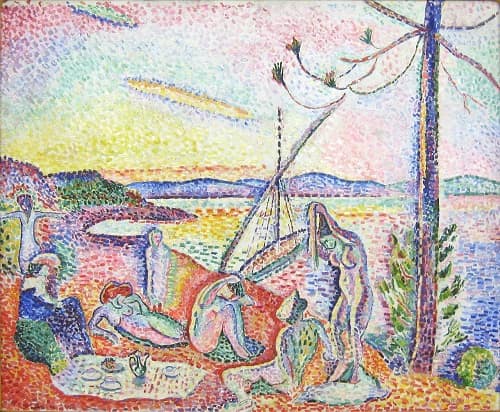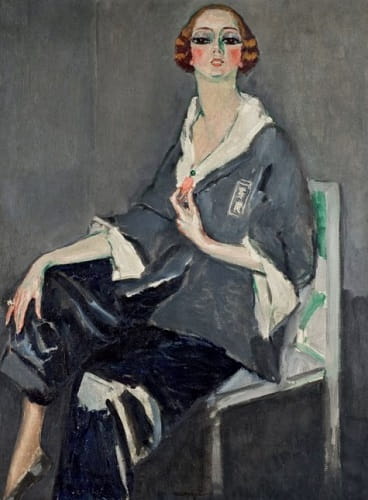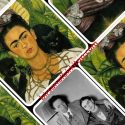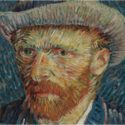Top 5 Most Important Representatives of the Fauvism Movement
Fauvism was a short-lived but influential art movement that emerged in France in the early 20th century. It is characterized by the use of bold, vibrant colors, and strong brushstrokes to create an emotional impact. The term “Fauvism” comes from the French word “Fauve,” which means “wild beast,” and was coined by a critic who was shocked by the movement’s use of color.
Fauvism emerged as a reaction against the academic art of the time, which was characterized by its adherence to traditional techniques and subject matter. Fauvist artists sought to break free from these constraints and explore new ways of expressing themselves through color and form.
The Fauvist style is characterized by the use of bright, bold colors, often applied in broad, sweeping brushstrokes. The colors used were often unrealistic or exaggerated and were intended to evoke a strong emotional response in the viewer. Fauvist artists were also known for simplifying forms, reducing them to their essential elements to create a more expressive effect.
So who were the most famous Fauvism Representatives? Let’s take a closer look!
Who Are the 5 Most Famous Painters of the Fauvism Movement?
1- Henri Matisse (1869-1954)
Henri Matisse is considered the founder and leading figure of the Fauvism movement. Henri Matisse’s early work was characterized by traditional techniques and muted colors, but in 1905, he produced a series of paintings that marked a radical departure from his earlier style. These paintings, which were exhibited at the Salon d’Automne in Paris, were characterized by their bold, bright colors and simplified forms, and they shocked critics and viewers alike.

Henri Matisse (1869-1954) – Henri Matisse is considered the founder and leading figure of the Fauvism movement.
The critic Louis Vauxcelles coined the term “Fauvism” to describe the style of Matisse and his colleagues, and the name stuck. Although Matisse did not originally set out to start a new art movement, he quickly became associated with Fauvism, and his work came to define the movement.
Recommended For You – 8 Amazing Facts About Henri Matisse
Matisse’s Fauvist works were influenced by the Post-Impressionist painters, such as Paul Cézanne and Vincent van Gogh, as well as by African and Oceanic art, which he saw at the Musée du Trocadéro in Paris. Matisse was particularly interested in the way that these cultures used bold, simple forms and bright colors to create expressive works of art.
Matisse’s Fauvist works, such as “Luxury, Calm and Pleasure” and “The Joy of Life,” are characterized by their use of bold, bright colors, simplified forms, and flattened space. They are also notable for their emotional intensity and the way they evoke a sense of pleasure and sensuality.

Luxury, Calm and Pleasure, 1904 by Henri Matisse – Top 5 Most Important Representatives of the Fauvism Movement
Although Matisse continued to evolve as an artist after the Fauvism movement ended, his work from this period remains one of the most important and influential examples of early modern art.
2- André Derain (1880 – 1954)
André Derain was a French painter who, along with Henri Matisse, was one of the key figures in the Fauvism movement.

André Derain (1880 – 1954) – Derain was a French artist who, along with Matisse, helped to develop Fauvism. His works often featured bright colors and strong brushstrokes, and he was known for his landscapes and portraits. – Top 5 Most Important Representatives of the Fauvism Movement.
André Derain and Henri Matisse met while studying at the Académie Julian in Paris in the early 1900s, and they quickly became friends and artistic collaborators.
Like Matisse, Derain was interested in breaking away from the traditional techniques and subject matter of academic art. He was particularly drawn to the work of Vincent van Gogh and Paul Cézanne, as well as to the bright colors and bold brushstrokes of traditional African and Oceanic art.
Derain’s Fauvist works, such as “The Dance” and “Charing Cross Bridge,” are characterized by their use of bright, bold colors and simplified forms. Derain was particularly interested in the effects of light and color, and he often used color to create a sense of movement and energy in his works.

The Dance, 1906 by André Derain – Top 5 Most Important Representatives of the Fauvism Movement.
Derain’s contributions to the Fauvism movement were significant, and his work helped to shape the style and direction of the movement. However, unlike Matisse, Derain eventually moved away from Fauvism, and his later work was characterized by a more classical style and a return to traditional techniques.
Despite this, Derain’s contributions to Fauvism remain an important part of the movement’s legacy, and his work continues to be studied and admired by art historians and enthusiasts around the world.
3- Maurice de Vlaminck (1876-1958)
Maurice de Vlaminck was a French painter who was one of the key figures of the Fauvism movement. Like many of the Fauvist artists, Vlaminck was interested in breaking away from the traditional techniques and subject matter of academic art, and he was particularly drawn to the use of color as a way to express emotion and create a sense of energy and movement.

Maurice de Vlaminck (1876-1958) – Vlaminck was a French painter and writer who was associated with the Fauvism movement. He was known for his use of bold colors and expressive brushstrokes, and his works often depicted rural landscapes and scenes of everyday life.
Maurice de Vlaminck’s Fauvist works, such as “The River Seine at Chatou” and “The Red Trees,” are characterized by their bold, bright colors and expressive brushstrokes. Vlaminck was particularly interested in the effects of light and color, and he often used color to create a sense of dynamism and excitement in his works.

The River Seine at Chatou, 1906 by Maurice de Vlaminck – Top 5 Most Important Representatives of the Fauvism Movement.
Vlaminck was also known for his independent spirit and his rejection of the established art world. He was critical of the Salon system, which he felt favored traditional art forms and stifled artistic innovation, and he preferred to exhibit his work in alternative venues such as cafés and art galleries.
Despite his contributions to the Fauvism movement, Vlaminck eventually moved away from the style, and his later works were characterized by a more subdued color palette and a return to traditional techniques. Nonetheless, his contributions to the Fauvism movement remain an important part of its legacy, and his work continues to be studied and admired by art historians and enthusiasts around the world.
4- Kees van Dongen (1877-1968)
Kees van Dongen was a Dutch-French painter who was associated with the Fauvism movement. Van Dongen’s work is characterized by bold, vibrant colors and expressive brushstrokes, and he was known for his portraits of Parisian society women, which often featured dramatic lighting and intense colors.

Kees van Dongen (1877-1968) – Dongen was a Dutch painter who was part of the Fauvism movement. He was known for his portraits of fashionable women, which often featured bright colors and bold outlines.
Van Dongen was influenced by the work of Henri Matisse, who was one of the founders of the Fauvism movement. Like Matisse, van Dongen was interested in the use of color to express emotion and create a sense of energy and movement, and he often used intense colors to create a sense of drama and excitement in his works.
Van Dongen’s Fauvist works, such as “The Dancer” and “Portrait de Mme Jasmy”, are characterized by their bold, bright colors, which often contrast sharply with the dark outlines of the figures. Van Dongen was also interested in the effects of light and shade, and he often used dramatic lighting to heighten the emotional impact of his works.

Portrait de Mme Jasmy, 1916 by Kees van Dongen – Top 5 Most Important Representatives of the Fauvism Movement.
Despite his association with the Fauvism movement, van Dongen was never a strict adherent to its principles, and he often experimented with other styles and techniques throughout his career. Nonetheless, his contributions to the Fauvism movement remain an important part of its legacy, and his work continues to be studied and admired by art historians and enthusiasts around the world.
5- Raoul Dufy (1877 – 1953)
Raoul Dufy was a French painter who was associated with the Fauvism movement. Dufy’s work is characterized by his use of bold, bright colors and loose, expressive brushstrokes, and he was particularly interested in the effects of light and color on the natural world.

Raoul Dufy (1877 – 1953) – Dufy was a French artist known for his vibrant paintings of scenes from everyday life, such as beaches, cafes, and sporting events. He was influenced by the Fauvism movement but later moved towards a more decorative style.
Raoul Dufy was influenced by the work of the Fauvist artists, particularly Henri Matisse and André Derain. Like the Fauvists, Dufy was interested in breaking away from the traditional techniques and subject matter of academic art, and he sought to create a new kind of art that was more expressive and emotional.
Dufy’s Fauvist works, such as “Regatta at Cowes” and “The Electric Fairy,” are characterized by their use of bright, intense colors, which often seem to vibrate with energy. Dufy was particularly interested in the effects of light on color, and he often used color to create a sense of movement and dynamism in his works.

Regatta at Cowes, 1934 by Raoul Dufy – Who Are the 5 Most Famous Painters of the Fauvism Movement?
Despite his association with the Fauvism movement, Dufy’s work was never limited to a single style or technique. He continued to experiment with different styles throughout his career, and his later works were characterized by a more decorative and ornamental style that incorporated elements of Cubism and Art Nouveau.
Nonetheless, Dufy’s contributions to the Fauvism movement remain an important part of its legacy, and his work continues to be studied and admired by art historians and enthusiasts around the world.
References:
- https://en.wikipedia.org/wiki/Luxe,_Calme_et_Volupt%C3%A9
- https://www.biography.com/artists/henri-matisse
- https://barnies.fr/andre-derain/
- https://smarthistory.org/andre-derain-the-dance/
- https://www.artnet.com/artists/irving-penn/portrait-de-maurice-de-vlaminck-ipsN_gQ2e-HVCvB9LXe40A2
- https://www.metmuseum.org/art/collection/search/490034
- https://nl.wikipedia.org/wiki/Kees_van_Dongen
- https://www.galeriemessine.com/en/artists/53-raoul-dufy/overview/
- https://www.nga.gov/collection/art-object-page.52174.html








